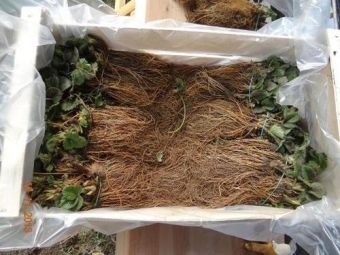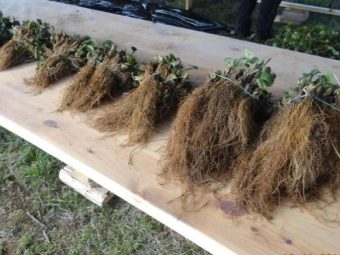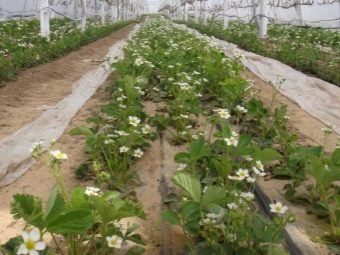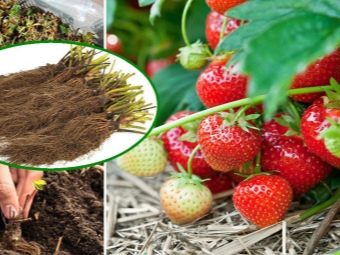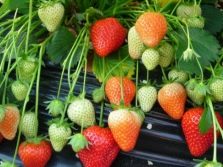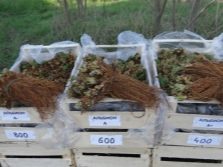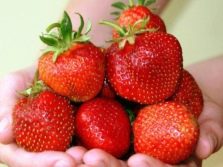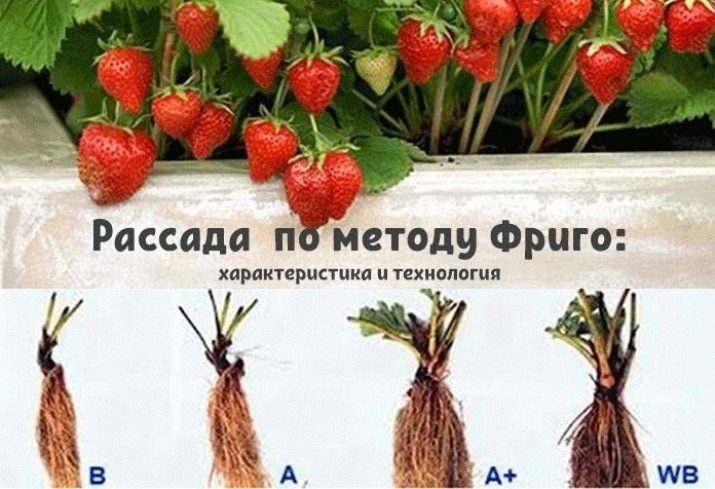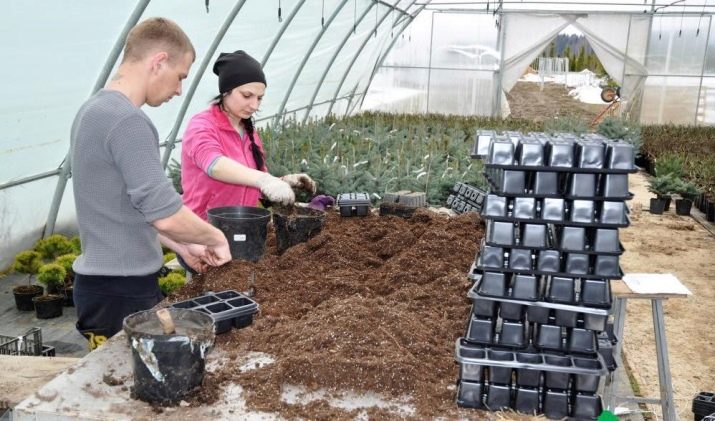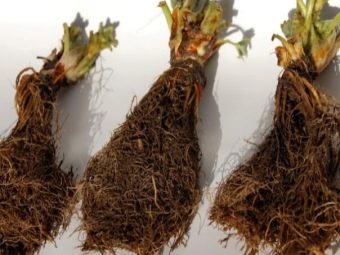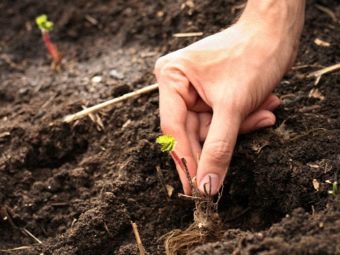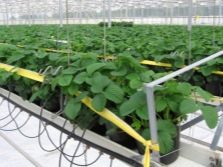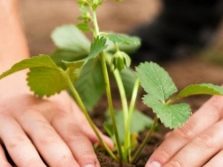Growing strawberries using Frigo technology
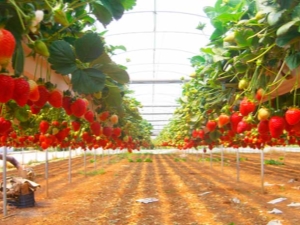
The Frigo technology is one of the advanced modern techniques and solves the problem of obtaining strawberry harvest all year round. Invented and approved in Holland method of growing and preserving seedlings, was quickly evaluated and adopted by Russian summer residents.
The essence of the method
There is an erroneous opinion that Frigo is one of the planting varieties of strawberries, however, this is fundamentally wrong. Technology Frigo called the process of growing, selection and storage of seedlings of garden strawberries. It begins with the spring planting of high-yielding strawberries in sandy or sandy-like soils. They carefully care for plants and fertilize them, however, they are not allowed to bloom. For this purpose, all flower stalks are removed from the maternal individuals, and the plant is forced to direct all its forces towards the appearance of offspring.
The newly born shoots also fertilize well and await their ripening, which occurs in November. The leaves of the plants at this time become dark brown, and the roots - dark brown. Only the ends of the root processes remain white. Shrubs are dug and placed in refrigerators. In this form, the seedlings are stored until spring planting, and in the case of greenhouse cultivation can be planted after five weeks.
Digging up seedlings in November is done only after the plant enters the state of rest. This is done with the help of special equipment, thanks to which the bushes remain intact, and the root system is not injured. Then the shoots are cleaned, sorted and cleaned for storage. When sorting shoots from the roots, the ground is shaken off, and large leaves are removed from the stem. Washing and trimming the roots is strictly prohibited. The air temperature in the rooms where the seedlings are selected and processed does not exceed 12-14 degrees. In such conditions, the shoots are at least 48 hours.
Further, the bushes are treated with fungicides (“Fundazole” or “Vincite Forte”), sorted by the grades and diameters of the root necks, and tied in bunches from 50 to 100 pieces. in each. Then the seedlings are placed in plastic bags or boxes, pre-covered with film. At the same time, the thickness of polyethylene cannot exceed 0.4-0.5 mm. If the seedlings are placed in 1 mm thick bags, they will die. In one package may be 400-700 prepared shoots.
Next, the plants are placed in refrigeration systems, where, at a humidity of 90% and temperatures from zero to two degrees of frost, they can be stored for 9 months. The storage period of seedlings is considered a very important step. An increase in air temperature even by one degree will inevitably lead to premature awakening of the shoots, and its subsequent decrease will cause the death of the plants. Due to the state of complete rest, in which the plants are located during this time, all the nutrients accumulated by them during their stay in the garden are preserved.
In addition, seedlings can be transported to any distance, and the main condition for this will be only the maintenance of the desired thermal mode. When transporting plants for longer distances, the seedlings are packaged in sphagnum moss, which prevents the formation of rot and prevents the appearance of mold. Using this technology allows you to make large stocks of planting material and use it for year-round cultivation of culture.
Advantages and disadvantages
A large number of positive reviews about the technology of Frigo due a number of important advantages of this technique.
- Plants perfectly take root and begin to grow rapidly. The first fruiting is possible already next year. This is explained by the fact that, unlike seedlings with a closed root system, Frigo saplings fall into a state of rest, and do not waste energy on maintaining vital cycles. Plants are as if in anabiosis, and when creating favorable conditions, they quickly wake up and begin to flourish.
- The possibility of long-term storage allows you to engage in the cultivation of strawberries all year round.
- Due to the unique form of packaging, shoots can be transported over any distance and be on the road for up to three weeks. Moreover, the loss of the basic properties and violations of plant biorhythms does not occur.
- A large number of fruits is due to the selection of only high-yielding varieties as maternal individuals.
- Excellent survival rate and early aging allow 8 weeks after planting to shoot the first harvest.
- The guarantee of the complete absence of diseases and pests is due to the careful care of the plants and the storage conditions of the plants.
The disadvantages of technology include too high cost of seedlings and the short effect of precociousness. The following year, the plant will no longer differ from the bushes grown in the traditional way. In addition, the shoots are not well suited for growing in cold climates, so their use in such areas is often limited.
Classification
Strawberries grown according to the technology of Frigo are conventionally divided into four types. The main classification criteria is the number of peduncles and the size of the root necks. Necks of shortened shoots are called parts of plants that are between the leaf rosettes and roots.
- A-class shoots have only two peduncles and are used for planting on small plantations. The size of the neck reaches 12-15 mm, and the yield is 4 tons per hectare, while from one bush it is possible to collect from 150 to 250 g of berries.
- Class A + shoots as well as the previous form, they have 2-3 peduncles, however, the diameters of the root necks have a little more, and are 15-18 mm. The crop yield reaches 10 t / ha. The class is widespread and is used to form large plantations for late harvest.
- Class A + Extra shoots (in some sources, WB-class) are quite expensive planting material and are distinguished by the use of elite varieties with a yield of up to 20 t / ha. The neck has a diameter of up to 24 mm, and the number of fruits can reach five units. The high yield of this class is due to the presence of side horns, so that it is possible to collect up to 500 g of berries per season from one bush.
- Saplings of V-class differ from the previous ones in that the fruiting of such species begins only after the season, the plants have one flower stalk that is cut off in the first season. The size of the root collar is 8-12 mm.
Agricultural engineering rules
Growing strawberries, obtained by the method of Frigo, includes a number of important measures, from the competent implementation of which depends on plant health and future harvest.
Awakening seedlings
It is recommended to thaw plants in unopened packages at room temperature. For this plant for a day left in the room, while avoiding abrupt changes in temperature. If the defrosting process needs to be accelerated, the packaging is opened and the shoots are watered with warm water. However, this can be done only if absolutely necessary, since ideally the plants should wake up naturally, gradually waking up.
After a day the seedlings are released from the packaging and straightened. Then poured into a shallow bowl of cold water and put the roots of shoots there. This will help the plants to quickly replenish their supply of lost moisture and enter the active phase more painlessly. In the water you need to add any of the growth promoters. Well proven treatment "Kornovinom", "hetoraksinom" and "Zircon".
When soaking the roots, it is important not to allow the composition to fall on the core of the leaves, since these drugs are intended for the roots and their effect may adversely affect the development of the above-ground escape.
Landing rules
Leave the roots in the open air after soaking can be no more than 15 minutes.Therefore, the soil for planting seedlings should be prepared in advance, preferably in the fall. For this purpose, 30 g of potassium salts, 10 kg of rotted mullein and 60 g of superphosphate are calculated per 1 m2 of area. Then the earth is carefully dug up and left to winter. In the spring, 30 days before planting, the soil is dug up again. It is considered the most rational to plant seedlings on high ridges, followed by mulching or shelter with agrotextiles. The formation of belt and two-line ridges is allowed. Shrubs in this case should be located not less than 25-30 cm apart.
The roots of the shoots during planting must be carefully straightened, and, if necessary, shortened to 12 cm. It is impossible to plant them in a well with a bundle. This can cause a room of root processes and make them defenseless before infection. When lowering the shoots in the wells, you need to ensure that the sockets are located above the ground, and the root of the neck was, on the contrary, reliably sprinkled. Immediately after planting, the soil around the shoot is well crimped and spills abundantly.
Watering
After planting, the plants need to be watered daily for 10 days. Then they are transferred to weekly watering, while spending up to 10 liters of water per square meter. During the flowering period, the intervals between watering increase to 10 days. This is required to ensure that the berries are sweet and juicy. Excessive moistening can lead to wateriness and loss of taste.
During the formation of the ovaries, the plants should receive two supplements at an interval of two weeks. To do this, prepare a solution consisting of 20 g of ammonium nitrate and a bucket of water. Instead of saltpeter, use of urea is allowed. Fertilizer is applied in the basal way, in which it is important to prevent the solution from getting onto the surface of the sheet rosettes. Otherwise, the process of decay may begin and the shoot will fall ill.
In addition to watering and feeding, plants require constant removal of weeds and loosening the soil. If the process of growing strawberries is planned to be carried out in one growing season, then after the end of fruiting, the plants are removed from the plantation and destroyed. If the culture is grown further, in the fall it is covered with spruce branches and left to hibernate.
Strawberries grown according to the technology of Frigo are suitable for growing crops. Plants have excellent health, well take root and guarantee a high yield.
For information on how to grow strawberries with Frigo technology, see the next video.

